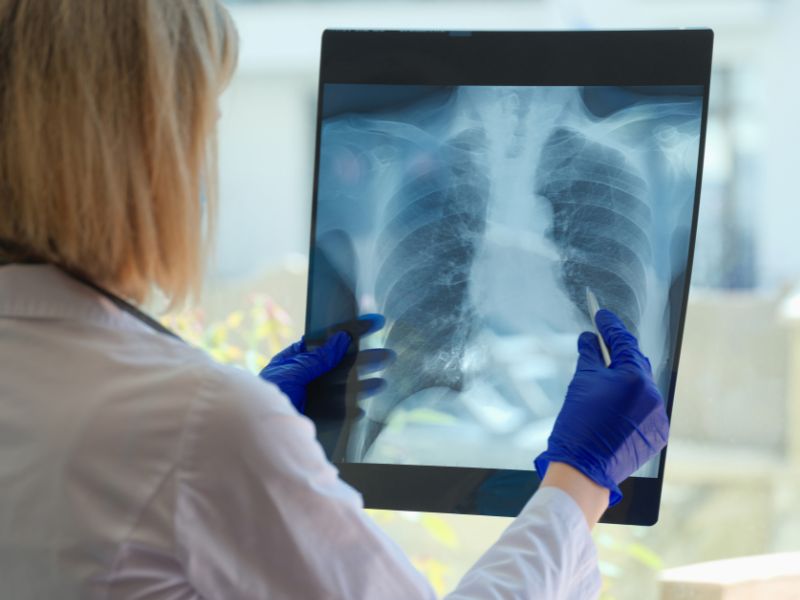If you’ve been told you have pulmonary fibrosis, or if you’re caring for someone who has, you probably have a lot of questions. What exactly is happening in the lungs? What caused this? And most importantly, what can be done about it? Let’s break down everything you need to know about this condition in terms that actually make sense.
What Is Pulmonary Fibrosis?
Pulmonary fibrosis (PF) is a type of interstitial lung disease that causes scarring and thickening in your lung tissue. This makes the lungs stiff, reducing their ability to expand and take in oxygen. (Imagine trying to breathe through a thick, stiff towel.) As a result, your body may not get enough oxygen to function normally. PF is usually permanent and gets progressively worse over time.
What Causes Pulmonary Fibrosis?
In most cases, the cause of pulmonary fibrosis is not known; this is called idiopathic pulmonary fibrosis (IPF). When we can identify a cause, it’s usually one of these:
- Long-term exposure to environmental pollutants (asbestos, silica, mold, dust)
- Certain autoimmune conditions, including rheumatoid arthritis, lupus and scleroderma
- Past lung infections
- Side effects from certain medications or radiation therapy
- Smoking
Am I at Risk for Pulmonary Fibrosis?
In addition to the causes above, you might also be at a higher risk for pulmonary fibrosis if you are older than 50; are male; have a history of smoking; or work in certain industries like mining, farming, or construction.
What Are the Symptoms of Pulmonary Fibrosis?
The most common symptoms of pulmonary fibrosis develop gradually and include:
- Shortness of breath
- Persistent dry cough
- Fatigue
- Unexplained weight loss
- Aching muscles and joints
- “Clubbing” (widening and rounding) of the fingertips or toes
Because these symptoms can be similar to other lung conditions, it’s important to get evaluated by a healthcare provider for an accurate diagnosis.
How Is Pulmonary Fibrosis Diagnosed?
Getting a proper diagnosis usually involves several steps:
Physical Examination: Your doctor will listen to your lungs for crackling sounds and ask about your symptoms and medical history.
Imaging Tests: Doctors may use imaging tests, such as chest X-rays and computed tomography (CT) scans, to diagnose the disease.
Lung Function Tests: Pulmonary function tests may be used to find out how much damage has been done and how well your lungs are working.
Lung Biopsy: In some cases, a small tissue sample may be needed to confirm the diagnosis.
What Treatment Options Are Available?
While there’s currently no cure for PF, treatments can slow disease progression, reduce symptoms, and improve quality of life. Your doctor may recommend anti-fibrotic medications that reduce inflammation and slow lung scarring. Oxygen therapy and pulmonary rehabilitation are commonly prescribed to maintain oxygen levels and increase breathing strength. In severe cases, a lung transplant may be needed.
Many people also benefit from inhaled maintenance medications delivered via a nebulizer, which help keep airways open and reduce irritation. Inhalation therapy can be more convenient for patients who have difficulty swallowing pills or require frequent medication.
Research is ongoing into new inhaled therapies specifically for pulmonary fibrosis, including nebulized versions of anti-fibrotic drugs and novel compounds designed for lung delivery.
Living Well with Pulmonary Fibrosis
A pulmonary fibrosis diagnosis can feel overwhelming, but remember that treatments continue to improve and many people live fulfilling lives with proper care. Key strategies include:
- Following your treatment plan exactly as prescribed
- Staying active within your limitations
- Getting vaccinated against flu and pneumonia
- Avoiding respiratory irritants like smoke and strong chemicals
- Eating well to maintain your strength
- Connecting with support groups for emotional support and practical tips
Pulmonary fibrosis is a serious condition, but it’s not one you have to face alone. With proper medical care, the right medications and equipment, and a strong support system, many people with PF continue to lead meaningful lives. The key is working closely with your healthcare team and ensuring you have reliable access to all prescribed treatments.
If your treatment plan includes respiratory medications or nebulizer therapy, America’s Best Care Plus is here to support you. Contact our respiratory care team to learn how we can help ensure you have the medications and equipment you need, delivered reliably to your home.
Related Reading:
Common Respiratory Medications Used to Treat Breathing Problems

